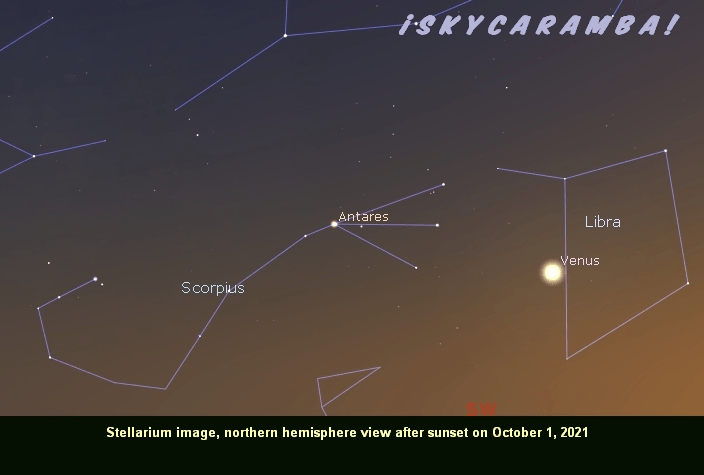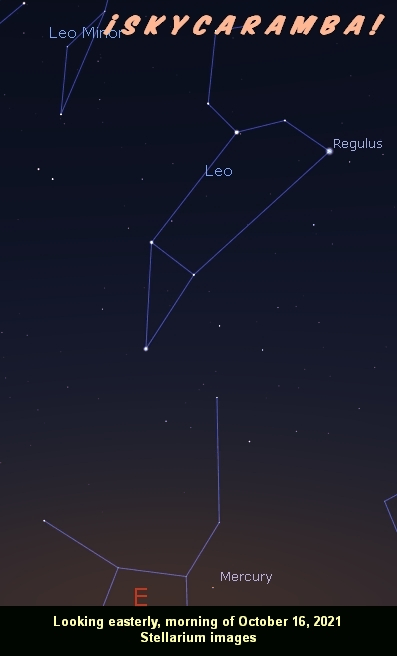
Venus is just outside the Libra diamond on the east side when the sun sets on October 1st. For northern hemisphere observers, the planet sets not long after sunset despite being at its greatest elongation later this month. The planet moves eastward into Scorpius, coming close to Dschubba on the 9th. A thin young moon passes by that evening. Venus passes Alniyat on the 14th and Antares on the 16th. Then it’s on to the space below Ophiuchus. The planet is at greatest elongation 47.0° east of the sun on the 29th. The point from which the planet shines on the 31st is almost directly between us and the center of the Milky Way Galaxy.

Mercury starts the month in the evening sky. On the 1st, it’s next to Spica. Viewers from around 22° south get the best view with the objects setting about an hour after the sun. The messenger planet is just left of the star about 1.5° from it. Northern hemisphere viewers shouldn’t expect to see Mercury just yet. Wait until about the middle of the month and look for it in the morning. As the sun passes through Virgo and Mercury through inferior conjunction, the planet becomes a morning object that will pause near Porrima for a few days and then head eastward through Virgo again on a path north of Spica. Mercury reaches greatest elongation 18.4° west of the sun on the 25th.

Jupiter and Saturn remain in Capricornus. The former makes a triangle with Deneb Algedi and Nashira. The latter is south of Algedi and Dabih. Saturn is practically stationary all month, but careful observation with binoculars or a telescope will help you see it change from retrograde to direct motion on the 11th. Jupiter is retrograde for the first half of the month, then is nearly stationary for a week, and in more noticeable direct motion again by the 25th. The actual date it resumes direct motion is the 18th. See the waxing gibbous moon pass near Saturn on the 13th and 14th and Jupiter on the 14th and 15th.

Where’s Mars this month? Too close to the sun to see. It’s in solar conjunction on the 8th. NASA will pass a few weeks without any communication with its Perseverance rover because the sun is a great source of radio noise. It won’t be possible to send or receive information between Earth and Mars with the sun in or very close to the line of sight. Perseverance will take measurements and perform a few tasks and then report whatever data it has when communication is reestablished
Of the meteor showers known in October, the Draconids and the Orionids offer the best prospects. Watch for the Draconids on the 8th. The shower has a sharp peak. That means you shouldn’t expect to see many before or after the peak which may favor European and Asian observers this year. Most years, the shower produces fewer than ten meteors per hour. But some observers in Europe were treated to a rate of 600 per hour in 2011. They radiate from Draco, a constellation partly circling the Little Dipper and the north celestial pole. The high declination means you can see the meteors all night from middle to high northern latitudes. It’s probably not impossible for you to see a Draconid meteor in the southern hemisphere, but it would be unusual and you’d have a hard time figuring out if its path traces back to Draco.
The Orionids peak on the 21st. The moon will be just past full, so you shouldn’t expect to see anything but the brightest that morning. On the other hand, this shower has a broad peak. You could see some Orionids a week or two before the peak while the moon isn’t in the morning sky but Orion is high. And given the constellation’s position on the celestial equator, this meteor shower is for northern and southern hemisphere sky watchers.
The moon’s circumstances in October: The moon is new and crossing the equator going south on the 6th. It’s at perigee on the 8th at a distance of 363,400 km. Southern lunistice is on the 12th at 26.2°. First quarter is the next day. It goes north of the equator on the 19th, is full on the 20th, and reaches apogee on the 24th at 405,600 km. Northern lunistice is on the 26th at 26.3°. Last quarter is on the 28th.
